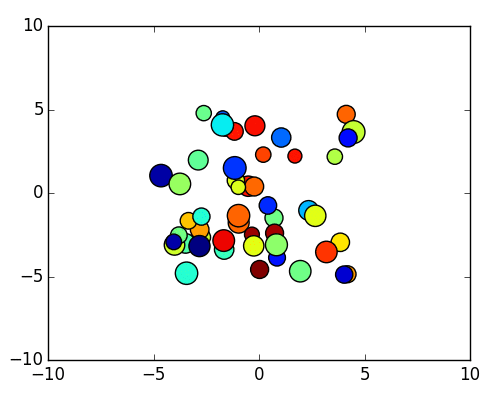I'm trying to do an animation of a scatter plot where colors and size of the points changes at different stage of the animation. For data I have two numpy ndarray with an x value and y value:
data.shape = (ntime, npoint) x.shape = (npoint) y.shape = (npoint) Now I want to plot a scatter plot of the type
pylab.scatter(x,y,c=data[i,:]) and create an animation over the index i. How do I do this?
Animations in Matplotlib can be made by using the Animation class in two ways: By calling a function over and over: It uses a predefined function which when ran again and again creates an animation. By using fixed objects: Some animated artistic objects when combined with others yield an animation scene.
Suppose you have a scatter plot, scat = ax.scatter(...), then you can
change the positions
scat.set_offsets(array) where array is a N x 2 shaped array of x and y coordinates.
change the sizes
scat.set_sizes(array) where array is a 1D array of sizes in points.
change the color
scat.set_array(array) where array is a 1D array of values which will be colormapped.
Here's a quick example using the animation module.
It's slightly more complex than it has to be, but this should give you a framework to do fancier things.
(Code edited April 2019 to be compatible with current versions. For the older code see revision history)
import matplotlib.pyplot as plt import matplotlib.animation as animation import numpy as np class AnimatedScatter(object): """An animated scatter plot using matplotlib.animations.FuncAnimation.""" def __init__(self, numpoints=50): self.numpoints = numpoints self.stream = self.data_stream() # Setup the figure and axes... self.fig, self.ax = plt.subplots() # Then setup FuncAnimation. self.ani = animation.FuncAnimation(self.fig, self.update, interval=5, init_func=self.setup_plot, blit=True) def setup_plot(self): """Initial drawing of the scatter plot.""" x, y, s, c = next(self.stream).T self.scat = self.ax.scatter(x, y, c=c, s=s, vmin=0, vmax=1, cmap="jet", edgecolor="k") self.ax.axis([-10, 10, -10, 10]) # For FuncAnimation's sake, we need to return the artist we'll be using # Note that it expects a sequence of artists, thus the trailing comma. return self.scat, def data_stream(self): """Generate a random walk (brownian motion). Data is scaled to produce a soft "flickering" effect.""" xy = (np.random.random((self.numpoints, 2))-0.5)*10 s, c = np.random.random((self.numpoints, 2)).T while True: xy += 0.03 * (np.random.random((self.numpoints, 2)) - 0.5) s += 0.05 * (np.random.random(self.numpoints) - 0.5) c += 0.02 * (np.random.random(self.numpoints) - 0.5) yield np.c_[xy[:,0], xy[:,1], s, c] def update(self, i): """Update the scatter plot.""" data = next(self.stream) # Set x and y data... self.scat.set_offsets(data[:, :2]) # Set sizes... self.scat.set_sizes(300 * abs(data[:, 2])**1.5 + 100) # Set colors.. self.scat.set_array(data[:, 3]) # We need to return the updated artist for FuncAnimation to draw.. # Note that it expects a sequence of artists, thus the trailing comma. return self.scat, if __name__ == '__main__': a = AnimatedScatter() plt.show() 
If you're on OSX and using the OSX backend, you'll need to change blit=True to blit=False in the FuncAnimation initialization below. The OSX backend doesn't fully support blitting. The performance will suffer, but the example should run correctly on OSX with blitting disabled.
For a simpler example, which just updates the colors, have a look at the following:
import matplotlib.pyplot as plt import numpy as np import matplotlib.animation as animation def main(): numframes = 100 numpoints = 10 color_data = np.random.random((numframes, numpoints)) x, y, c = np.random.random((3, numpoints)) fig = plt.figure() scat = plt.scatter(x, y, c=c, s=100) ani = animation.FuncAnimation(fig, update_plot, frames=range(numframes), fargs=(color_data, scat)) plt.show() def update_plot(i, data, scat): scat.set_array(data[i]) return scat, main() If you love us? You can donate to us via Paypal or buy me a coffee so we can maintain and grow! Thank you!
Donate Us With